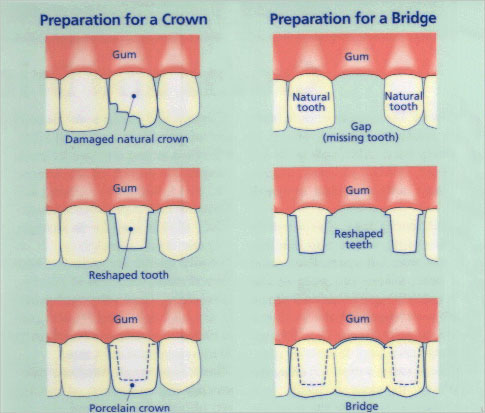Crowns and Bridges
If you have a broken or weakened tooth, a crown or "cap" can give the tooth a new lease of life. A dental bridge is made up of artificial teeth which are permanently fixed to healthy supporting teeth by crowns. Non-metallic options are also available. more about crowns and bridge.

What are crowns?
If a tooth has been broken, or weakened by a lot of decay or a large filling, a crown can be fitted. Your dentist will match the crown’s shape and color to your other teeth so it will look natural. The crown will last for many years, depending on the health of the tooth underneath. A temporary crown is put over the tooth until the permanent crown is prepared.
What are bridges?
A bridge consists of crowns which are permanently fixed to healthy supporting teeth. It is used to replace missing teeth, restoring appearance and function. A bridge can be made of either porcelain, porcelain fused to metal or zirconia When preparing a conventional bridge, the dentist needs to shape the teeth either side of the gap so that they will successfully hold the bridge.A typical bridge is illustrated below. The natural teeth either side of the space have been prepared to have crowns fitted. These crowns are permanently fused to an artificial tooth in the centre.
What is the process for obtaining a crown or bridge?
The process of fitting crowns and bridges requires two visits. During the first session our dentist takes X-rays to assess the health of your mouth. In case of crowns the tooth receiving the crown is trimmed. In case of bridges the supporting teeth are trimmed. Preparation involves recontouring these teeth by removing a portion of enamel to allow room for a crown to be placed over them. A shade guide is used to select the correct colour of porcelain.
Impressions are taken of the prepared teeth and the teeth of the opposite jaw. A temporary bridge or crown may be bonded to protect the prepared teeth between visits (you must also avoid hard or sticky food and keep the temporary bridge or crown clean). During the second session: the temporary bridge or crown is removed. The permanent crown or bridge is checked for colour and fit. If you and your dentist are happy with your crown or bridge, it is permanently fixed in place with dental glue.
How do I care for my crown or bridge?
While a crowned tooth does not require any special care, you should continue to follow good oral hygiene practices, including brushing your teeth at least twice a day and flossing once a day - especially around the crown area where the gum meets the tooth.
Bridges are cemented in place, so they cannot be removed for cleaning. To keep the teeth healthy, the gap under a bridge must be cleaned daily using special dental floss - an ordinary toothbrush will not do the job. Your dentist will demonstrate how to use floss under your bridge.
What materials are used for crowns and bridges?
Our dentists work with permanent crowns and bridges of porcelain fused to metal or porcelain fused to gold and also offers metal-free crowns and bridges.the latest in crown aesthetics is the ZIRCONIA crown.
Porcelain-fused-to-metal dental crowns and bridges are colour matched to your neighboring teeth.
Next to all-ceramic crowns, porcelain-fused-to-metal crowns look most like natural teeth. However, sometimes the metal underlying the crown's porcelain can show through as a dark line, especially at the gum line and even more so if your gums recede. These crowns can be a good choice for front or back teeth. In case of front teeth the dentist can use aesthetic shoulder porcelain to cover the mentioned dark line, this way they can achieve a far better aesthetic result.
All-ceramic or all-porcelain dental crowns and bridges provide a better natural colour match than the metal fused ones. However, they are not as strong as porcelain-fused-to-metal crowns and bridges and they wear down opposing teeth more than metal crowns. All-ceramic crowns are a good choice for front teeth.